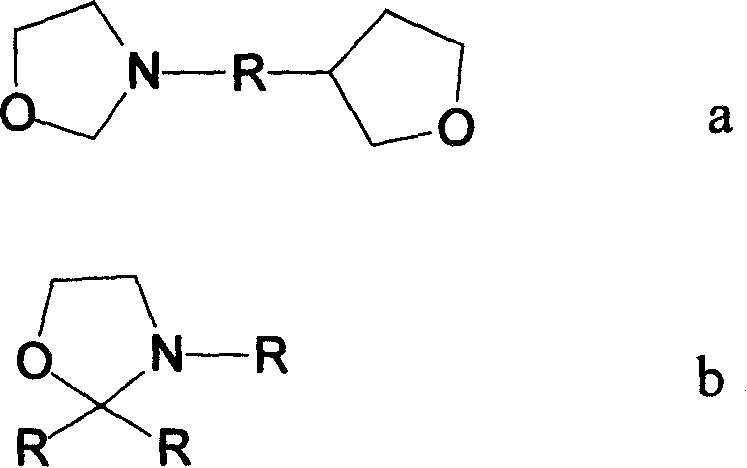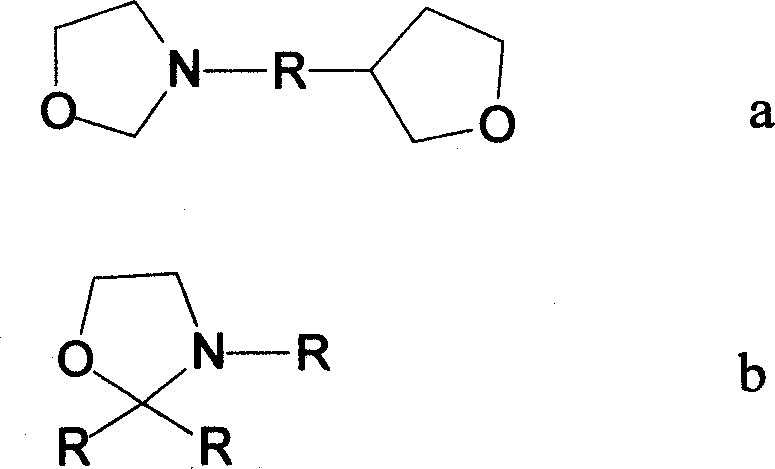Environment protection polyurethane terrace self levelling paint varnish and preparing method
A polyurethane, environmentally friendly technology, applied in the direction of polyurea/polyurethane coatings, coatings, etc., can solve the problems of not considering the self-leveling problem of coatings, production, construction workers and environmental hazards, and the effect is not obvious, etc., to enhance self-leveling. The effect of improving the leveling performance, shortening the dry time, and solving the problem of self-leveling
- Summary
- Abstract
- Description
- Claims
- Application Information
AI Technical Summary
Problems solved by technology
Method used
Image
Examples
example 1
[0044] The amount of raw materials is parts by weight
[0045] Toluene diisocyanate (TDI) 20.75
[0046] Polyether N210 33.60
[0047] (Molecular weight is 1000, hydroxyl value = 100±10KOHmg / g)
[0048] Xylene 40
[0049] Trimethylolpropane 5.15
[0050] Dibutyltin dilaurate 0.25
[0051] Antioxidant 0.25
[0052] In a four-neck round bottom flask equipped with a stirrer, a heating platform, a thermometer, a reflux condenser and an inert gas introduction tube, add xylene and polyether N210 according to the amount required, and heat to 100°C for dehydration for 6 hours. Then add trimethylolpropane, control the temperature at 145°C, stir, keep for 3 hours to fully dehydrate, cool to 55°C, add dibutyltin dilaurate and antioxidant, finally add toluene diisocyanate (TDI), exothermic Keep at 70°C for 4 hours. At this time, the mixed system should be colorless, transparent or light yellow. The temperature is raised to 140-146°C to reflux the solvent xylene and water to steam out. After co...
example 2
[0056] The amount of raw materials is parts by weight
[0057] Toluene diisocyanate (TDI) 25.5
[0058] Polyether N210 27.53
[0059] (Molecular weight is 1000, hydroxyl value = 100±10KOHmg / g)
[0060] Xylene 30.0
[0061] Butyl acetate 10.0
[0062] Trimethylolpropane 6.47
[0063] Dibutyltin dilaurate 0.25
[0064] Antioxidant 0.25
[0065] In a four-neck round bottom flask equipped with a stirrer, a heating platform, a thermometer, a reflux condenser and an inert gas introduction tube, add xylene, butyl acetate, and polyether N210 according to the amount required, and heat to 100°C for dehydration for 6 hours. Then add trimethylolpropane, control the temperature at 145°C, stir, keep for 3 hours to fully dehydrate, cool to 55°C, add dibutyltin dilaurate and antioxidant, finally add toluene diisocyanate (TDI), exothermic Keep at 70°C for 4 hours. At this time, the mixed system should be colorless, transparent or light yellow. The temperature is raised to 140-146°C to reflux the s...
example 3
[0068] The amount of raw materials is parts by weight
[0069] Toluene diisocyanate (TDI) 24.8
[0070] Polyether N210 21.1
[0071] (Molecular weight is 1000, hydroxyl value = 100±10KOHmg / g)
[0072] Xylene 50.0
[0073] Trimethylolpropane 3.90
[0074] Dibutyltin dilaurate 0.1
[0075] Antioxidant 0.05
[0076] Benzoyl chloride 0.05
[0077] In a four-neck round bottom flask equipped with a stirrer, a heating platform, a thermometer, a reflux condenser and an inert gas introduction tube, add xylene and polyether N210 according to the amount required, and heat to 100°C for dehydration for 6 hours. Then add trimethylolpropane, control the temperature at 145°C, stir, keep for 3 hours to fully dehydrate, cool to 55°C, add dibutyltin dilaurate and antioxidant, finally add toluene diisocyanate (TDI), exothermic Add benzoyl chloride slowly at 70°C and keep it for 4 hours. At this time, the mixed system should be colorless, transparent or light yellow. The temperature is raised to 140-1...
PUM
 Login to View More
Login to View More Abstract
Description
Claims
Application Information
 Login to View More
Login to View More - R&D
- Intellectual Property
- Life Sciences
- Materials
- Tech Scout
- Unparalleled Data Quality
- Higher Quality Content
- 60% Fewer Hallucinations
Browse by: Latest US Patents, China's latest patents, Technical Efficacy Thesaurus, Application Domain, Technology Topic, Popular Technical Reports.
© 2025 PatSnap. All rights reserved.Legal|Privacy policy|Modern Slavery Act Transparency Statement|Sitemap|About US| Contact US: help@patsnap.com


